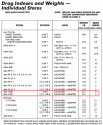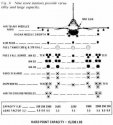Brumby
Major
I wonder why the PLAAF hasn't yet developed a triple rack launcher. That would give it much more flexibility in terms of payload. 3 missiles, or 2 missiles and a drop tank/bomb/ASCM, etc.
Like this:
View attachment 54452
That F-15 could load 12 AMRAAMs, 2 Sidewinders, and 3 drop tanks with this setup.
Boeing is actually now testing a quadruple rack (the AMBER):
View attachment 54453
A J-10 with 2 triple racks and 4 single racks could load 6 MRAAMs, 2 SRAAMs, and 3 drop tanks, or 8 MRAAMs, 2 SRAAMs, and 1 drop tank. Facing an incoming saturation cruise missile attack, that would be alot of firepower to defend with.
It is a position premised on “what is good for the goose is good for the gander”. The question therefore revolves around whether the weapons loadout that is on the F-15 is necessarily suitable or even possible on the J-10. Given that performance data or details on the J-10 is rather limited, it would be impossible to conduct any technical assessment to make an objective determination. However, the science of aerodynamics and in particular drag coefficient is universal and we can make some reasonable judgement based on deductive reasoning.
A key set of data associated with drag coefficient is the drag index and the driver of the index is the wing area of a plane. In reality every store item and its associated drag index on a F-15 will be different to another plane that has a different wing area. For example, the wing area of a F-15 is 608 sq. ft but the J-10 has a wing area of 360 sq. ft. How significant is this of the relative drag of an identical store item? We cannot answer this directly given that we are comparing US and Chinese weapons. However, we can reasonably adopt a surrogate in the form of the F-16 as it has a wing area of 300 sg. ft and in the same class as the J-10.
You initially posited a loadout of “12 AMRAAMs, 2 Sidewinders, and 3 drop tanks”. I will use this configuration to compare the drag index between the F-15 and the F-16.
The following is a basic configuration of the F-16C with weight and drag index information. I will use some of its information to build the total weight and drag index associated with it. It should be noted that the triple ejector rack (TER) in practice cannot be used for the AIM-120 but we will assume that it is possible for this exercise.

12 AIM-120 will require 4 TERs and come with it the following weight/DI addition.
4 TERs/1636lbs/68
12 AIM-120/4092/48*
*per table below

In effect, the 12 AIM-120 loadout (even if possible) will increase total weight by 5728 lbs and drag of 116. Making adjustments to the basic configuration will mean a total weight load of 40000 lbs and a drag index well over 200
In comparison, the following is the basic configuration of the F-15C.

I don’t have the individual store DI tables for the F-15 as with the F-16 but the data above should be sufficient to make a comparative calculation of 12 AIM-120 and its drag index.
12 AIM-120/4656lbs/15.6
6 LAU-128/A/666lbs/7.2
In total it is 5322lbs and 22.8 DI.
While the weight associated with the 12 AIM-120 is approximately similar between the F-15 and the F-16, the DI between the two is significantly different i.e. 116 vs. 22.8 and that is 5 times.
Clearly what is good for the goose is not necessarily good for the gander.
Such a loadout will push the DI of the F-16 to above 200 and a weight load to 40000 lbs. You might take the view, so what? We know it will degrade performance but what’s the deal? As an example, the following analysis demonstrate a DI above 200 will result in the F-16 being unable to transonic to supersonic.


